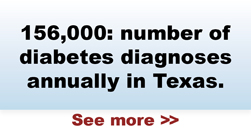We live in a world where advertisers promise that just one pill will work. Politicians declare that health care reform is either nirvana or Armageddon. At the start of a new year, many of us think, “If I just keep this one resolution to…(eat less, workout more, breathe), I will become a fountain of youth and vitality.” But the truth is that there is no one, singular health care crisis—and no one, perfect solution. Individual and community health are incredibly interconnected, interdependent, and downright complicated to understand and improve.
And while it’s tempting to stick our heads in the sand—or our hands back in the cookie jar—we simply can no longer avoid the facts: our population is getting sicker, and healthcare is costing more—for our individual wallets as well as government coffers. As just one example, Texas is the 10th most obese state in the country, and obesity cost the state of Texas more than $3.3 billion in 2005. That number is expected to balloon (pun intended) to almost $16 billion per year by 2025*. Obesity is directly related to diabetes, and Texas diabetes rates also continue to climb, having cost the state $3.7 billion in 2003.
This month, Forefront partners with five central Texas organizations to discuss the biggest health issues facing our community and each organization’s unique approach to making us healthier. What we see is a need to approach health from several directions: how people access it, how the medical system is structured, how the community supports and considers health, and how we as individuals approach our own health.
The good news is that we’ve got some great resources right here to help us make the changes that will not only help us drop a pants size, but also keep central Texas economically competitive and healthy.
Our partners start with the responsibility that we all need to take for our own health and for cultivating habits that can lead to healthy futures. AISD sees a connection between childhood obesity and test scores and is working in the classroom and the community to trim waistlines so children can learn effectively. Support for healthy habits needs to continue outside the classroom. The University of Texas Health Services and the Center for Students in Recovery are keeping college students healthy as they find independence and build habits to find success in their own lives.
And Paul Carrozza, of RunTex and the RunTex Carrozza Foundation, has developed a model that cultivates healthy habits and extends those opportunities throughout Austin. His approach can get the most devout couch potato moving—but more importantly, his model is spreading that change on organizational and community levels.
In addition to personal responsibility, individuals need access to appropriate healthcare, including mental healthcare. El Buen Samaritano discusses how stress affects health and offers a model of integrated healthcare that addresses mental health issues and provides a complete continuum of care for its specific community. Central Health discusses the impact of a provider shortage on people’s ability to get the health care they need. Central Texas faces the challenge of not having enough health care practitioners. Without enough doctors, some of our most vulnerable and sick neighbors won’t be able to secure the healthcare they need.
As Patricia Young Brown of Central Health says, “We can’t keep doing the same thing and expect a different result.” These partners offer their views on how communities AND individuals can make adjustments that will improve central Texas’s health.
So, in case you haven’t made your 2011 resolutions, we encourage you to read these partner articles and find the area of change you can get behind. Each partner offers a way for you to get involved in its organization or to take your own steps toward improving your health and the health of central Texas.
Happy New Year, and here’s to OUR health. Salud!












